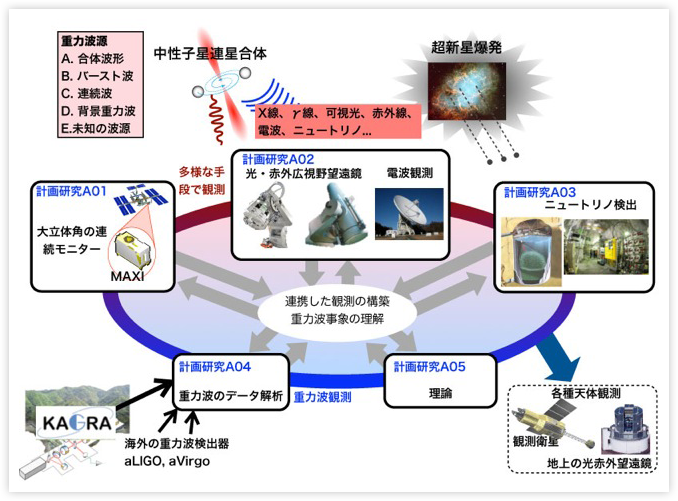On September 14, 2015, the Laser Interferometer Gravitational-Wave Observatory (LIGO) observed a transient gravitational-wave signal. It was found that the signal was from the inspiral and merger of a pair of black holes with masses about 30 times the solar mass.
Such black hole mergers are expected to be difficult to observe with telescopes using electromagnetic waves. However, it is expected that other phenomena such as neutron star mergers emit electromagnetic waves and gravitational waves with enough signal strength. Simultaneous observations with electromagnetic telescopes and gravitational wave telescopes are likely to be a game changer in modern astrophysics.
 Some astronomical events, for example compact binary mergers, are expected to emit gravitational waves. We can investigate such events more precisely if we can observe them with multiple methods, such as neutrinos and electromagnetic waves (image: Kakenhi Shingakujyutsu "New Developments in Astrophysics Through Multi-Messenger Observations of Gravitational Wave Sources").
Some astronomical events, for example compact binary mergers, are expected to emit gravitational waves. We can investigate such events more precisely if we can observe them with multiple methods, such as neutrinos and electromagnetic waves (image: Kakenhi Shingakujyutsu "New Developments in Astrophysics Through Multi-Messenger Observations of Gravitational Wave Sources").
Estimation of the source location
A gravitational wave telescope can 'hear' the sound of the wave, but it is difficult to determine the direction of the source. Thus we can only know the direction of the 14-Sep-15 event with an accuracy of 600 square degrees on the sky. This field is too large for other astronomical telescopes to identify the corresponding object. However, simultaneous observations with multiple gravitational wave telescopes including KAGRA will be able find out the direction of the signal source with enough accuracy for electromagnetic telescopes to locate the corresponding object.
Observation of binary neutron star mergers with optical telescopes
The neutron star merger is one of the most interesting gravitational wave sources for multi-messenger astronomy. According to the theoretical model proposed by Dr. Tanaka of NAOJ, simultaneous emission in infrared light and gravitational waves is expected when binary neutron stars merge. Thanks to its wide field of view, the Hyper Supreme Cam of the Subaru telescope is the optimum instrument for detecting such phenomena.
Supernova and neutrino
Gravitational wave emission from supernovae is also expected. With the measurement accuracy of the current gravitational wave telescopes, we can only observe gravitational wave signals from supernovae in our galaxy, and the event rate in our galaxy is very small. However, if/when it happens we can observe the phenomena with a neutrino detector such as Super Kamiokande in addition to electromagnetic wave telescopes. According to the theoretical model, neutrinos come first, then gravitational wave, and finally electromagnetic waves. The international gravitational wave telescope community is preparing an observation network with such instruments across the globe.
